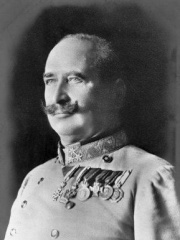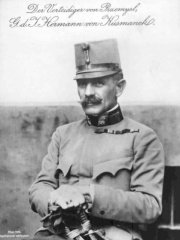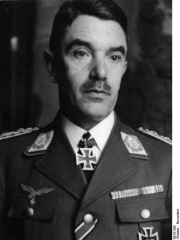
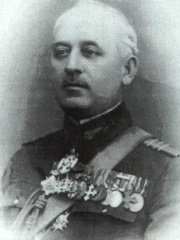
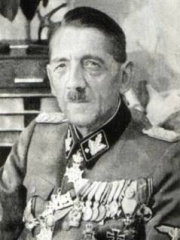
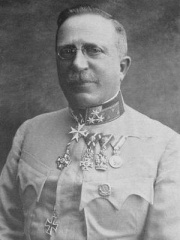
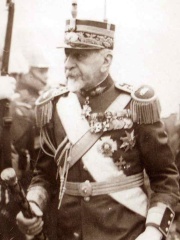
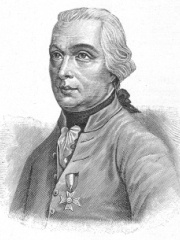
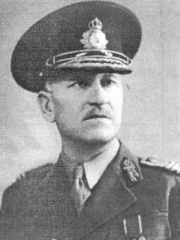
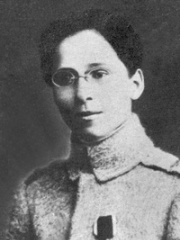
The Most Famous
MILITARY PERSONNELS from Romania
This page contains a list of the greatest Romanian Military Personnels. The pantheon dataset contains 2,058 Military Personnels, 12 of which were born in Romania. This makes Romania the birth place of the 22nd most number of Military Personnels behind Finland, and Serbia.
Top 10
The following people are considered by Pantheon to be the top 10 most legendary Romanian Military Personnels of all time. This list of famous Romanian Military Personnels is sorted by HPI (Historical Popularity Index), a metric that aggregates information on a biography's online popularity. Visit the rankings page to view the entire list of Romanian Military Personnels.

1. Alexander Löhr (1885 - 1947)
With an HPI of 69.66, Alexander Löhr is the most famous Romanian Military Personnel. His biography has been translated into 33 different languages on wikipedia.
Alexander Löhr (20 May 1885 – 26 February 1947) was an Austrian Air Force commander during the 1930s and, after the annexation of Austria, he was a Luftwaffe commander. Löhr served in the Luftwaffe during World War II, rising to commander of Army Group E and then to commander-in-chief in Southeastern Europe (OB Südost). Löhr was one of three Austrians who rose to the rank of Generaloberst (colonel general) in the German armed forces. The other two were Lothar Rendulic and Erhard Raus. Löhr was captured by Yugoslav Partisans at the end of the war in Europe. He was tried and convicted of war crimes by the Yugoslav government for anti-partisan reprisals committed under his command, and the bombing of Belgrade in 1941. He was executed by firing squad on 26 February 1947 in Belgrade, Yugoslavia.

2. Petre Dumitrescu (1882 - 1950)
With an HPI of 67.52, Petre Dumitrescu is the 2nd most famous Romanian Military Personnel. His biography has been translated into 23 different languages.
Petre Dumitrescu (Romanian pronunciation: [ˈpetre dumiˈtresku]; 18 February 1882 – 15 January 1950) was a Romanian general during World War II who led the Romanian Third Army on its campaign against the Red Army in the Eastern Front.

3. Artur Phleps (1881 - 1944)
With an HPI of 67.11, Artur Phleps is the 3rd most famous Romanian Military Personnel. His biography has been translated into 23 different languages.
Artur Gustav Martin Phleps (German pronunciation: [ˈaʁtuːɐ̯ ˈɡʊstaf ˈmaʁtiːn ˈflɛps]; 29 November 1881 – 21 September 1944) was an Austro-Hungarian, Romanian and Nazi German army officer who held the rank of SS-Obergruppenführer und General der Waffen-SS (lieutenant general) in the Waffen-SS during World War II. An Austro-Hungarian Army officer before and during World War I, Phleps specialised in mountain warfare and logistics, and had been promoted to Oberstleutnant (lieutenant colonel) by the end of the war. During the interwar period he joined the Romanian Army, reaching the rank of General de divizie (major general), and also became an adviser to King Carol. After he spoke out against the government, he was sidelined and asked to be dismissed from the army. In 1941, he left Romania and joined the Waffen-SS as an SS-Standartenführer (colonel) under his mother's maiden name of Stolz. Seeing action on the Eastern Front as a regimental commander with the SS Motorised Division Wiking, he later raised and commanded the 7th SS Volunteer Mountain Division Prinz Eugen, raised the 13th Waffen Mountain Division of the SS Handschar (1st Croatian), and commanded the V SS Mountain Corps. Units under his command committed many crimes against the civilian population of the Independent State of Croatia, German-occupied territory of Serbia and Italian governorate of Montenegro. His final appointment was as plenipotentiary general in south Siebenbürgen (Transylvania) and the Banat, during which he organised the evacuation of the Volksdeutsche (ethnic Germans) of Siebenbürgen to the Reich. In addition to the Knight's Cross of the Iron Cross, Phleps was awarded the German Cross in Gold, and after he was shot and killed in the aftermath of the 1944 Romanian coup d'état, he was awarded the Oak Leaves to his Knight's Cross.

4. Arthur Arz von Straußenburg (1857 - 1935)
With an HPI of 65.76, Arthur Arz von Straußenburg is the 4th most famous Romanian Military Personnel. His biography has been translated into 21 different languages.
Arthur Freiherr Arz von Straußenburg (Hungarian: báró straussenburgi Arz Artúr; 16 June 1857 – 1 July 1935) was an Austro-Hungarian colonel general and last Chief of the General Staff of the Austro-Hungarian Army. At the outbreak of the First World War, he commanded the 15th Infantry Division. Soon, he was promoted to the head of the 6th Corps and the First Army. He participated on the Gorlice–Tarnów Offensive in 1915 and the countryside of Romania in 1916. In March 1917, he became Chief of the General Staff until his resignation on 3 November 1918.
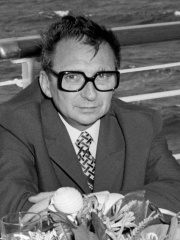
5. Ion Mihai Pacepa (1928 - 2021)
With an HPI of 64.07, Ion Mihai Pacepa is the 5th most famous Romanian Military Personnel. His biography has been translated into 24 different languages.
Ion Mihai Pacepa (Romanian pronunciation: [iˈon miˈhaj paˈt͡ʃepa]; 28 October 1928 – 14 February 2021) was a Romanian lieutenant general in the Securitate, the secret police of the Socialist Republic of Romania, who defected to the United States in July 1978 following President Jimmy Carter's approval of his request for political asylum. He was the highest-ranking defector from the former Eastern Bloc, and wrote books and articles on the inner workings of communist intelligence services. His best-known works are the books Disinformation and Red Horizons. At the time of his defection, Pacepa simultaneously had the rank of advisor to President Nicolae Ceaușescu, acting chief of his foreign intelligence service, and a parliamentary undersecretary at Romania's Ministry of Interior. Subsequently, he worked with the American Central Intelligence Agency (CIA) to bring down communism for more than 10 years. The CIA described his cooperation as "an important and unique contribution to the United States".

6. Constantin Prezan (1861 - 1943)
With an HPI of 62.08, Constantin Prezan is the 6th most famous Romanian Military Personnel. His biography has been translated into 21 different languages.
Constantin Prezan (January 27, 1861 – August 27, 1943) was a Romanian general during World War I. In 1930 he was given the honorary title of Marshal of Romania, as a recognition of his merits during his command of the Northern Army and of the General Staff. Besides his participation in World War I, he also took part in the Second Balkan War and the 1918–1920 military operations for safeguarding the Great Union. He avoided getting actively involved in politics, although he had a series of political titles, which were rather honorary in nature. For instance, he held the title of senator by right, based on his high rank in the army, and that of member of the Crown Council of Romania.

7. Michael von Melas (1729 - 1806)
With an HPI of 60.21, Michael von Melas is the 7th most famous Romanian Military Personnel. His biography has been translated into 20 different languages.
Michael Friedrich Benedikt Baron von Melas (12 May 1729 – 31 May 1806) was a Transylvanian-born General of the cavalry of Greek descent for the Austrian Empire during the Napoleonic Wars. He was born in Radeln, Transylvania, (nowadays Roadeș, part of Bunești commune, Brașov County, Romania) in 1729 and joined the Austrian Army at age 17. He served in the Seven Years' War as aide de camp for Leopold Josef Graf Daun. He was promoted to colonel in 1781. He fought on the lower Rhine in 1794 and the middle Rhine in 1795. Von Melas later led, as General of the cavalry, the Austrian Army in Italy during Napoleon Bonaparte's campaigns in Italy, part of the War of the Second Coalition. Serving under Russian field marshal Alexander Suvorov, who commanded Second Coalition forces, he commanded Austrian forces in victories at the battles of Cassano, Trebbia, Novi, Genola, and the Siege of Genoa, and came near to another victory over Napoleon at the Battle of Marengo before making the mistake of handing over command to a subordinate for what he thought was the pursuit from the field of a beaten foe. A stand made by the French forces further down the road, and a subsequent counter-attack by the French General Louis Desaix led to a defeat for von Melas' forces. The day after the battle he was compelled to sign the Convention of Alessandria, which gave the rule of Italy up to the Mincio River to Napoleon, the Habsburg Crown's authority being in consequence forced out of Italy. Von Melas was later a Habsburg commander in Bohemia. He retired in 1803. He died in 1806 at Týnec nad Labem, in Bohemia.

8. Constantin Constantinescu-Claps (1884 - 1961)
With an HPI of 60.14, Constantin Constantinescu-Claps is the 8th most famous Romanian Military Personnel. His biography has been translated into 18 different languages.
Constantin Constantinescu-Claps (February 20, 1884 – June 1961) was a Romanian general during World War II who commanded the Romanian Fourth Army at the Battle of Stalingrad.

9. Ecaterina Teodoroiu (1894 - 1917)
With an HPI of 59.65, Ecaterina Teodoroiu is the 9th most famous Romanian Military Personnel. Her biography has been translated into 24 different languages.
Ecaterina Teodoroiu (Romanian pronunciation: [ekateˈrina te.odoˈroju]; formal rendition of Cătălina Toderoiu; 14 January 1894 – 3 September 1917) was a Romanian woman who fought on the front and died in World War I, and is regarded as a heroine of Romania. A Romanian Scouts member, she had initially worked as a nurse but she subsequently decided to become a front-line soldier, being deeply impressed by the patriotism of the wounded and the death of her brother Nicolae, a sergeant in the Romanian Army. It was an unusual decision for a woman of that era, so she was sent to the front rather reluctantly. However, with the support of the Romanian royal family, she was able to serve in the military and eventually came to be seen as a symbol.
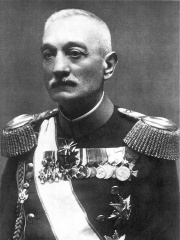
10. Prince Arsen of Yugoslavia (1859 - 1938)
With an HPI of 59.07, Prince Arsen of Yugoslavia is the 10th most famous Romanian Military Personnel. His biography has been translated into 15 different languages.
Prince Arsenije "Arsen" of Yugoslavia (Serbian: Арсеније Карађорђевић / Arsenije Karađorđević; 16/17 April 1859 – 19 October 1938) was a dynast of the House of Karađorđević and an ancestor of the current cadet branch of the Serbian royal family. He long served as an officer in the Russian Imperial Army.
People
Pantheon has 12 people classified as Romanian military personnels born between 1729 and 1928. Of these 12, none of them are still alive today. The most famous deceased Romanian military personnels include Alexander Löhr, Petre Dumitrescu, and Artur Phleps.
Deceased Romanian Military Personnels
Go to all RankingsAlexander Löhr
1885 - 1947
HPI: 69.66
Petre Dumitrescu
1882 - 1950
HPI: 67.52
Artur Phleps
1881 - 1944
HPI: 67.11
Arthur Arz von Straußenburg
1857 - 1935
HPI: 65.76
Ion Mihai Pacepa
1928 - 2021
HPI: 64.07
Constantin Prezan
1861 - 1943
HPI: 62.08
Michael von Melas
1729 - 1806
HPI: 60.21
Constantin Constantinescu-Claps
1884 - 1961
HPI: 60.14
Ecaterina Teodoroiu
1894 - 1917
HPI: 59.65
Prince Arsen of Yugoslavia
1859 - 1938
HPI: 59.07
Franz Rohr von Denta
1854 - 1927
HPI: 58.64
Hermann Kusmanek von Burgneustädten
1860 - 1934
HPI: 58.39
Overlapping Lives
Which Military Personnels were alive at the same time? This visualization shows the lifespans of the 12 most globally memorable Military Personnels since 1700.

